Related Research Articles
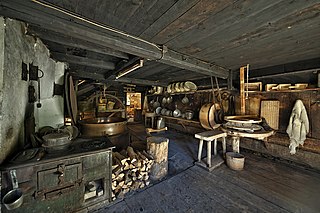
A dairy is a business enterprise established for the harvesting or processing of animal milk – mostly from cows or buffaloes, but also from goats, sheep, horses, or camels – for human consumption. A dairy is typically located on a dedicated dairy farm or in a section of a multi-purpose farm that is concerned with the harvesting of milk.
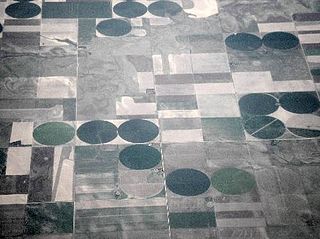
A farm is an area of land that is devoted primarily to agricultural processes with the primary objective of producing food and other crops; it is the basic facility in food production. The name is used for specialised units such as arable farms, vegetable farms, fruit farms, dairy, pig and poultry farms, and land used for the production of natural fibres, biofuel and other commodities. It includes ranches, feedlots, orchards, plantations and estates, smallholdings and hobby farms, and includes the farmhouse and agricultural buildings as well as the land. In modern times the term has been extended so as to include such industrial operations as wind farms and fish farms, both of which can operate on land or sea.

Holstein Friesians are a breed of dairy cattle originating from the Dutch provinces of North Holland and Friesland, and Schleswig-Holstein in Northern Germany. They are known as the world's highest-production dairy animals.
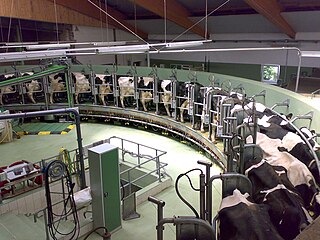
Dairy farming is a class of agriculture for long-term production of milk, which is processed for eventual sale of a dairy product.

Fonterra Co-operative Group Limited is a New Zealand multinational dairy co-operative owned by around 10,500 New Zealand farmers. The company is responsible for approximately 30% of the world's dairy exports and with revenue exceeding NZ$17.2 billion, is New Zealand's largest company.

Dairy cattle are cattle cows bred for the ability to produce large quantities of milk, from which dairy products are made. Dairy cows generally are of the species Bos taurus.

The Dairy Shorthorn is a British breed of dairy cattle. It developed from the Shorthorn, which itself came from County Durham, Northumberland and Yorkshire in north eastern England.
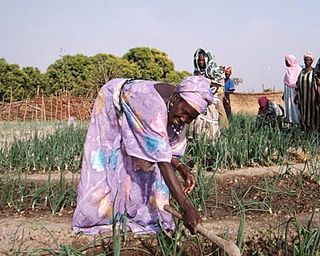
An agricultural cooperative, also known as a farmers' co-op, is a cooperative where farmers pool their resources in certain areas of activity. A broad typology of agricultural cooperatives distinguishes between 'agricultural service cooperatives', which provide various services to their individually farming members, and 'agricultural production cooperatives', where production resources are pooled and members farm jointly. Examples of agricultural production cooperatives include collective farms in former socialist countries, the kibbutzim in Israel, collectively governed community shared agriculture, Longo Mai co-operatives and Nicaraguan production co-operatives.

Pastoral farming is aimed at producing livestock, rather than growing crops. Examples include dairy farming, raising beef cattle, and raising sheep for wool. In contrast, arable farming concentrates on crops rather than livestock. Finally, Mixed farming incorporates livestock and crops on a single farm. Some mixed farmers grow crops purely as fodder for their livestock; some crop farmers grow fodder and sell it. In some cases pastoral farmers are known as graziers, and in some cases pastoralists. Pastoral farming is a non-nomadic form of pastoralism in which the livestock farmer has some form of ownership of the land used, giving the farmer more economic incentive to improve the land. Unlike other pastoral systems, pastoral farmers are sedentary and do not change locations in search for fresh resources. Rather, pastoral farmers adjust their pastures to fit the needs of their animals. Improvements include drainage, stock tanks, irrigation and sowing clover.

Automatic milking is the milking of dairy animals, especially of dairy cattle, without human labour. Automatic milking systems (AMS), also called voluntary milking systems (VMS), were developed in the late 20th century. They have been commercially available since the early 1990s. The core of such systems that allows complete automation of the milking process is a type of agricultural robot. Automated milking is therefore also called robotic milking. Common systems rely on the use of computers and special herd management software. Also it used to monitor the health status of cows.

Many farmers in India depend on animal husbandry for their livelihood. In addition to supplying milk, meat, eggs, wool, their castings (dung) and hides, animals, mainly bullocks, are the major source of power for both farmers and drayers. Thus, animal husbandry plays an important role in the rural economy. The gross value of output from this sector was ₹358 billion (US$5.0 billion) in FY 1989, an amount that constituted about 25 percent of the total agricultural output of ₹1.4 trillion (US$19.6 billion).

In New Zealand, agriculture is the largest sector of the tradable economy, contributing about two-thirds of exported goods in 2006–7. For the year ended March 2002, agricultural exports were valued at over $14.8 billion. New Zealand is unique in being the only developed country to be totally exposed to the international markets since subsidies, tax concessions and price supports for the agricultural sector were removed in the 1980s. However, as of 2017, the New Zealand Government still provides state investment in infrastructure which supports agriculture.
Happy Cow Creamery is a family-owned dairy farm in Pelzer, South Carolina that bottles and sells its own milk on site from the farm's closed herd of grass-fed Holstein cattle. The creamery's whole milk, buttermilk and chocolate milk is sold in the farm's on-site store and through grocery, convenience and country stores in Upstate region of South Carolina. The milk is not homogenized and is low-temperature pasteurized and inspected by the State of South Carolina.
Milk Income Loss Contract (MILC) Payments is the name given by USDA to the dairy farmer counter-cyclical payments program, authorized by the 2002 farm bill. Under the program, dairy farmers nationwide are eligible for a federal payment whenever the minimum monthly market price for farm milk used for fluid consumption in Boston falls below $16.94/cwt. A producer potentially can receive a payment equal to 45 percent of the difference between the $16.94 per cwt. target price and the market price, in any month that the Boston market price falls below $16.94. A producer can receive a payment on all milk production during that month, but no payments will be made on any annual production in excess of 2.4 million pounds per dairy operation. On average this limit is reached by a milking herd of 130 cows. MILC payments apply to production beginning December 1, 2002 through September 30, 2012.

Dairy farming in New Zealand began from small beginnings during the early days of colonisation by Europeans. The New Zealand dairy industry is based almost exclusively on cattle, with a total population of 4.8 million milking cows as of 2017. The income from dairy farming is now a major part of the New Zealand economy, becoming an NZ$13.4 billion industry by 2017.
Electrical energy efficiency on United States farms covers the use of electricity on farms and the methods and incentives for improving the efficiency of that use.
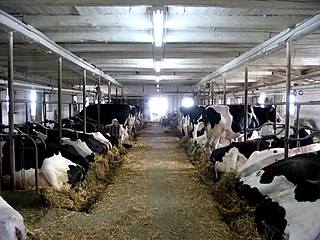
Dairy farming is one of the largest agricultural sectors in Canada. Dairy has a significant presence in all of the provinces and is one of the top two agricultural commodities in seven out of ten provinces.

Supply management (SM) is a national agricultural policy framework used in Canada that controls the supply of dairy, poultry and eggs through production and import controls and pricing mechanisms. Proponents of the framework tend to claim that it is designed to ensure that these farms can be profitable and Canadian consumers have access to a "high-quality, secure" supply of what they claim to be "sensitive products" at stable prices without shortages and surpluses. Opponents of the system tend to view it was an attempt by members of the supply managed industries to form a publicly supported cartel and profit at the expense of purchasers.
A herdshare is a contractual arrangement between a farmer and an owner of livestock - the shareholder or member - through which the shareholder is able to obtain raw milk, meat, offal and other profits of the livestock proportionate to the shareholder's interest in the herd. Herdshares include cowshares, goatshares, and sheepshares, and are sometime referred to as "farmshares" or "dairy-shares," although the term "farmshare" can also refer to an entire farm held in joint ownership.

Agriculture in Wales has in the past been a major part of the economy of Wales, a largely rural country that forms part of the United Kingdom. Wales is mountainous and has a mild, wet climate. This results in only a small proportion of the land area being suitable for arable cropping, but grass for the grazing of livestock is present in abundance. As a proportion of the national economy, the importance of agriculture has become much reduced; a high proportion of the population now live in the towns and cities in the south of the country and tourism has become an important form of income in the countryside and on the coast. Arable cropping is limited to the flatter parts and elsewhere dairying and livestock farming predominate.
References
- ↑ "Sharemilker". www.careers.govt.nz. Retrieved 2020-06-05.
- ↑ "Getting our Gypsy Day act together". Scoop Business. Federated Farmers. Scoop Media. Scoop. 2014-05-28. Retrieved 2014-06-04.
Thousands of farm animals and hundreds of households will be on the move in Gypsy day, as farms change hands and sharemilkers take up new contracts from Saturday, 31 May.
CS1 maint: others (link) - ↑ Ministry of Agriculture and Fisheries, New Zealand. "A Review of Sharemilking: 1972-1996". Archived from the original on 2006-05-16. Retrieved 2006-05-18.
| This agriculture article is a stub. You can help Wikipedia by expanding it. |